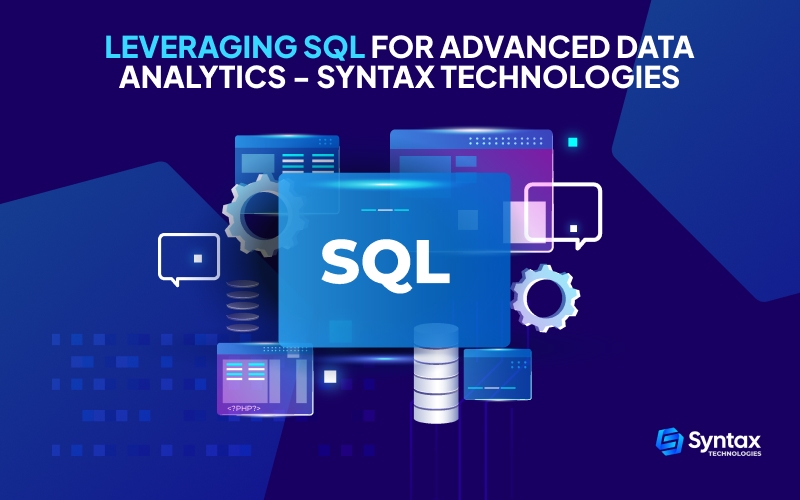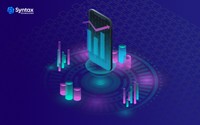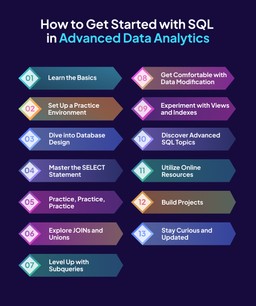Did you know that we generate a mind-boggling 2.5 quintillion bytes of data every day?
That’s like stacking DVDs from here to the moon and back ? every single day!
Imagine having the power to sift through this digital sea of information, extracting meaningful insights that could shape the future.
Well, my friend, you’re in for a treat because we’re about to unravel the mysteries of data analytics, and at the heart of it all is SQL ? your ticket to diving deep into this vast ocean of possibilities.
It can look challenging to understand such concepts, especially if you’re starting a new career in data analytics, but nothing that a great data analytics course can’t fix!
When there’s a will, there’s a way.
So now, are you ready to ride the data wave? Let’s roll!
Let’s delve into the key features that make advanced data analytics a game-changer:
Predictive Modeling
Ever wished you had a crystal ball to foresee the future? Well, predictive modeling is the next best thing. By analyzing historical data, advanced analytics can forecast future trends, helping you make informed decisions and stay one step ahead.
Machine Learning Integration
Say hello to the future! Machine learning algorithms are the powerhouses behind predictive analytics, allowing systems to learn and improve from experience without being explicitly programmed.
Real-Time Data Analysis
In the fast-paced digital age, yesterday’s data might as well be ancient history. Advanced analytics thrives on real-time data, enabling you to make decisions on the fly and respond to changing trends as they happen.
Data Visualization Mastery
Forget boring spreadsheets! Advanced analytics transforms data into visually stunning dashboards and interactive charts. It’s not just about numbers; it’s about telling compelling stories that even non-analysts can understand.
Prescriptive Analytics
Move over, predictions; it’s time for prescriptions. Prescriptive analytics anticipates what might happen and suggests actions to optimize outcomes. It’s like having a personal data-driven advisor guiding you toward the best course of action.
Natural Language Processing (NLP)
Who says you need to speak code to converse with data? NLP lets you interact with your data using everyday language, making analytics accessible to everyone, regardless of their coding prowess.
Data Security and Governance
With great data comes great responsibility. Advanced analytics prioritizes robust security measures and governance frameworks to ensure your data remains confidential, integral, and available when needed.
Scalability and Flexibility
Whether dealing with a small dataset or swimming in a sea of big data, advanced analytics tools scale to meet your needs. They’re flexible enough to adapt to the growing demands of your analytical endeavors.
There you have it ? the key features that make advanced data analytics not just a tool but a dynamic force shaping the future of decision-making.
So, where does SQL fit in? Continue reading to find out!
What’s SQL and How Does it Play a Role in Data Analytics?
SQL, which stands for Structured Query Language (and yes, you’ll soon be throwing around acronyms like a pro), is the language of databases.
Now, let’s break it down. Imagine you have a massive dataset, a digital Pandora’s box of information.
It’s raw, unorganized, and, frankly, overwhelming. This is where SQL swoops in like a superhero. It helps you structure your questions so the database understands, allowing you to pull out exactly what you need.
You throw a query at the database, and voil?! It responds with the precise information you’re after. SQL turns the chaos of raw data into a symphony of organized, actionable insights.
So, SQL is your go-to tool whether you’re dealing with customer data, sales figures, or the secret recipe for grandma’s cookies hidden in a database somewhere (just kidding).
It empowers you to slice, dice, and analyze data like a seasoned pro, transforming you from a mere mortal into a data superhero armed with the mighty SQL sword.
Excited? You should be! Get ready to unravel the true potential of data analytics as we venture deeper into the realms of SQL magic.
What are the Main SQL tools for Advanced Data Analytics?
Ah, the tools of the trade! Here are some SQL heavyweights that will be your companions in the world of advanced data analytics:
MySQL
- Description: An open-source relational database management system (RDBMS). Known for its speed and reliability, MySQL is a popular choice for various applications, from small projects to large-scale enterprises.
- Why It’s Awesome: It’s versatile, scalable, and has a vibrant community. Plus, it plays well with many programming languages.
PostgreSQL
- Description: Another open-source RDBMS, PostgreSQL is often hailed for its extensibility and compliance with SQL standards. It’s a robust option for complex data analytics tasks.
- Why It’s Awesome: Supports advanced data types, offers powerful indexing, and is known for its ACID compliance.
Microsoft SQL Server
- Description: A relational database management system developed by Microsoft. It’s a comprehensive solution that integrates seamlessly with Microsoft’s suite of products.
- Why It’s Awesome: Excellent integration with other Microsoft tools, strong security features, and optimal performance.
SQLite
- Description: A lightweight, serverless, self-contained database engine. It’s perfect for embedded systems and applications that require a compact yet powerful database.
- Why It’s Awesome: Zero configuration, easy to set up, and great for smaller projects or applications.
Oracle Database
- Description: A powerful and widely used relational database management system developed by Oracle. It’s a go-to choice for enterprises handling large volumes of data.
- Why It’s Awesome: Scalability, robustness, and an array of advanced features for data management.
SQL Server Management Studio (SSMS)
- Description: The official integrated environment for managing any SQL infrastructure. It’s the go-to tool for working with Microsoft SQL Server.
- Why It’s Awesome: Rich interface, powerful query editing capabilities, and efficient database management tools.
DBeaver
- Description: A free and open-source database tool supporting various databases, including MySQL, PostgreSQL, and SQLite. It provides a unified and intuitive interface for database management.
- Why It’s Awesome: Cross-platform, supports a wide range of databases, and offers features like schema compare and data transfer.
Tableau
- Description: While not a traditional SQL tool, Tableau is a powerful data visualization tool that integrates seamlessly with SQL databases. It helps turn raw data into interactive, insightful visuals.
- Why It’s Awesome: Drag-and-drop interface, real-time analytics, and a vibrant community. It’s like the artist’s palette for your data.
Looker
- Description: A data exploration and business intelligence platform that leverages SQL for data modeling. It’s designed to make SQL more accessible to non-technical users.
- Why It’s Awesome: Intuitive interface, powerful data modeling, and collaboration features.
pgAdmin
- Description: A comprehensive administration and management tool for PostgreSQL. It provides a graphical interface for database management tasks.
- Why It’s Awesome: User-friendly, supports multiple PostgreSQL versions and allows for efficient database monitoring.
These tools are your arsenal for conquering the vast landscapes of data analytics. Experiment with a few, find your favorites, and soon you’ll be weaving SQL magic with the tool that suits your style.
How to Get Started with SQL in Advanced Data Analytics
Embarking on your SQL adventure for advanced data analytics?
Fantastic choice! Here’s your roadmap to kickstart this thrilling journey:
Learn the Basics
Familiarize yourself with SQL fundamentals ? the SELECT statement, FROM clause, WHERE clause, and basic functions. Online platforms like Codecademy, W3Schools, or Khan Academy offer excellent introductory SQL courses.
Set Up a Practice Environment
Install a relational database management system (RDBMS) such as MySQL, PostgreSQL, or SQLite. Many of these systems have user-friendly interfaces, making it easier to practice SQL commands.
Dive into Database Design
Understand the principles of database design. Learn about tables, relationships, and keys. A well-designed database sets the foundation for effective data analytics.
Master the SELECT Statement
Drill down into the intricacies of the SELECT statement. Explore the use of aliases, aggregate functions (like COUNT, SUM, AVG), and sorting results with ORDER BY.
Practice, Practice, Practice
Apply your knowledge to real-world scenarios. Use sample databases, create your datasets, and craft queries to retrieve specific information. The more you practice, the more confident you’ll become.
Explore JOINs and Unions
Delve into JOIN operations to combine data from multiple tables. Understand INNER JOINs, LEFT JOINs, and other variations. Additionally, explore the power of UNION to merge results from different SELECT statements.
Level Up with Subqueries
Embrace the beauty of subqueries. Learn how to nest queries within queries to solve complex problems and extract precisely the data you need.
Get Comfortable with Data Modification
Understand how to modify data with INSERT, UPDATE, and DELETE statements. This is crucial for maintaining the integrity of your databases.
Experiment with Views and Indexes
Explore the creation of views for simplified data access. Understand how indexes can enhance query performance, especially with large datasets.
Discover Advanced SQL Topics
Tackle more advanced topics like window functions, stored procedures, and triggers. These concepts can add a layer of sophistication to your analytics toolkit.
Utilize Online Resources
Leverage online resources like Stack Overflow, SQL forums, and documentation. The SQL community is vast, and there’s a wealth of knowledge available to assist you.
Build Projects
Apply your skills to real projects. Whether it’s analyzing sales data, tracking user behavior, or creating a database for your favorite hobby, hands-on projects solidify your understanding.
Stay Curious and Updated
The world of data analytics is dynamic. Stay curious, explore new features, and keep up with industry trends. SQL is a tool that continuously evolves.
Remember, becoming proficient in SQL is a journey, not a sprint. Enjoy the process, celebrate small victories, and don’t hesitate to experiment.
Soon enough, you’ll find yourself wielding SQL with the confidence of a seasoned data analyst.
Mastering SQL with Syntax Technologies to Accelerate Your Analytics Career
As we draw the curtains on our exploration of data analysis SQL, you’re now equipped with the keys to unlock the vast potential hidden within databases.
But the journey doesn’t end here?it’s just the beginning of your data analytics adventure. The more you perform data analysis, the more you explore, practice, and experiment, and the more proficient you’ll become in wielding SQL as your analytical sword.
And speaking of accelerating your career in data analytics, Syntax Technologies is here to take your skills to the next level.
With a tailored data analytics and business intelligence course that caters to beginners and aspiring data analysts alike, you can dive deep into the world of SQL and emerge ready to tackle real-world data challenges.
Whether you’re seeking to enhance your current skill set or starting from scratch, our course is designed to fit your needs, providing hands-on experience and guidance from industry experts.
So, why wait?
Data analytics is calling, and Syntax Technologies is your gateway to answering that call.
Accelerate your data science career, master the art of SQL, and let your journey into the exciting realms of data analytics begin!



